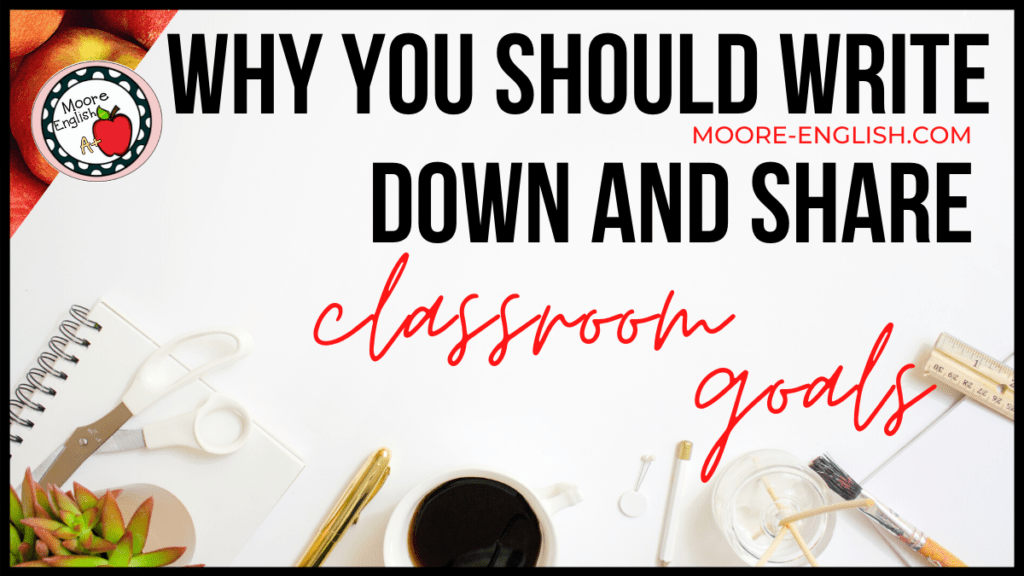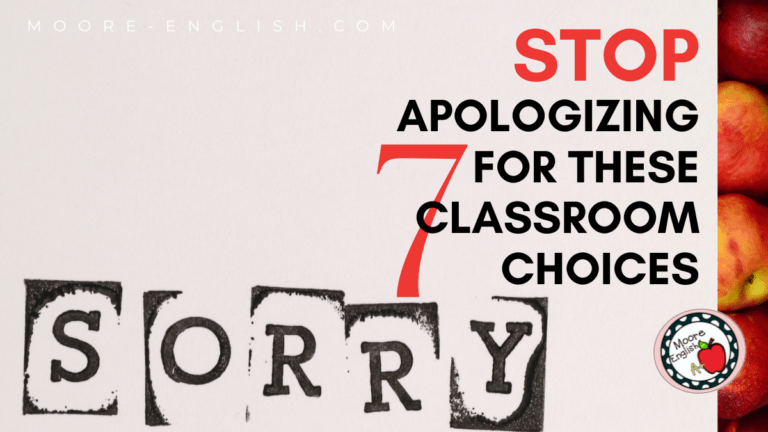At the beginning of each semester, I ask students to set goals related to reading and writing. Then, over the course of the next 18 weeks, we revisit those goals.
This post this post may contain affiliate links. Please read the Terms of Use.
Why You Should Write Down Goals
While my students set academic goals, I also set classroom goals. Plenty of research suggests that writing down goals is important. Such research suggests that writing down goals is important for two main reasons:
1. Science. Neuroscience suggests that “people who very vividly describe or picture their goals are anywhere from 1.2 to 1.4 times more likely to successfully accomplish their goals.” Furthermore, writing down your goals is part of whole-brain thinking. So now every aspect of your conscious mind is working toward helping you achieve your goals.
2. Accountability. After a challenging lesson or class, we often think, “Well, next time I’ll…”. While these are important internal dialogues and an essential part of professional growth, these dialogues are also easy to dismiss or forget. (If you’re not going to teach that lesson again until next semester, it is easy to forget!).
However, writing down goals promotes accountability and follow through. Suddenly, your internal dialogue is made solid and significant. It has weight and shape. Your dreams have become goals, and that can be scary but critical for making meaningful growth. Writing down your goals forces you to own them. It’s easy to add a place in your lesson plans for goal reflection and growth.

Why You Should Share Goals
In addition to writing down professional goals, it is also important to share those goals. Being honest with yourself about your classroom strengths and struggles is important. But it is just as important to share and communicate with others. When you share your goals with co-workers, peers, or teacher friends, these benefits arise:
1. Strength. Sharing your goals is not a sign of weakness but a profession of strength. By letting your peers know that you are aware of your own professional struggles, you signal a willingness to learn and grow. Further, you are modeling the kind of cognitive vulnerability that focuses meaningful professional growth and development, signaling to your peers that they can share similar #teachertruths without fear of judgement. This kind of sharing is a foundation of leadership.
2. Feedback. Now that you have shared your goals with your peers, they can help you achieve them. Instead of having one mind working toward your goals, you have multiple minds working toward a common goal. Your co-workers, peers, and teacher friends have valuable experiences and insights into teaching, learning, and growth. So drawing on their collective wisdom is key. They can provide creative solutions from an objective perspective you can’t access alone.

Sharing My Classroom Goals
In the interest of learning from my peers, I want to share my 2018-2019 teacher goals.
1. Increasing Positive Parent Phone Calls.
My school requires teachers to contact parents when students begin to fail a course. Since we usually send home progress reports in the third week of school, this is when I begin making parent contacts for grades. And, at that point in the year, I usually have a pretty good idea which students are independent readers and writers, which are struggling, and which are apathetic.
Making contact with parents can be essential to helping struggling or apathetic students make progress in class. However, this year, my goal is to make positive parent contact early and often. If grade reports go home the third week of school, my goal is to have made a positive parent contact for each of my potentially struggling or apathetic students–even if it’s as small as an email. My goal is to build a positive foundation with parents early! I recently designed this editable, free Google Form to help with the process.
2. Teaching Annotating Text Features.
My state is no longer a Common Core state. So our ELA standards don’t always match CCSS perfectly. However, both Common Core ELA standards and my state standards mention reading, comprehending, and analyzing text features.
Over the years, I have noticed my students struggling with text features. Sometimes because they just ignore a caption. Other times because they do not know how to read a graph. And sometimes because they do not know how to make an inference about a text based on a text feature. For these reasons, since my school is already doing a close reading and literacy push this year, I am going to put extra emphasis on helping students annotate and draw inferences from text features. PS: This was such a success! Read about how I learned to teach text features. And check out my favorite game for teaching text features!
How About You?
What are your resolutions going to be for the new school year? Share them below! I’d love to hear what you’re going to focus on in the next school year! Pick up my FREE student goal sheet!










